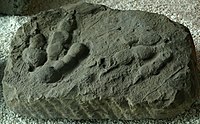
A fossil track or ichnite (Greek "ιχνιον" (ichnion) – a track, trace or footstep) is a fossilized footprint. This is a type of trace fossil. A fossil trackway is a sequence of fossil tracks left by a single organism. Over the years, many ichnites have been found, around the world, giving important clues about the behaviour (and foot structure and stride) of the animals that made them. For instance, multiple ichnites of a single species, close together, suggest 'herd' or 'pack' behaviour of that species.
Combinations of footprints of different species provide clues about the interactions of those species. Even a set of footprints of a single animal gives important clues, as to whether it was bipedal or quadrupedal. In this way, it has been suggested that some pterosaurs, when on the ground, used their forelimbs in an unexpected quadrupedal action.
Special conditions are required, in order to preserve a footprint made in soft ground (such as an alluvial plain or a formative sedimentary deposit). A possible scenario is a sea or lake shore that became dried out to a firm mud in hot, dry conditions, received the footprints (because it would only have been partially hardened and the animal would have been heavy) and then became silted over in a flash storm.
The first ichnite found was in 1800 in Massachusetts, US, by a farmer named Pliny Moody, who found 1-foot (31 cm) long fossilized footprints. They were thought by Harvard and Yale scholars to be from "Noah's Raven".[1]
A famous group of ichnites was found in a limestone quarry at Ardley, 20 km Northeast of Oxford, England, in 1997. They were thought to have been made by Megalosaurus and possibly Cetiosaurus. There are replicas of some of these footprints, set across the lawn of Oxford University Museum of Natural History (OUMNH).
A creature named Cheirotherium was, for a long time and still may be, only known from its fossilized trail. Its footprints were first found in 1834, in Thuringia, Germany, dating from the Late Triassic Period.
The largest known dinosaur footprints, belonging to sauropods and dating from the early Cretaceous were found to the north of Broome on the Dampier Peninsula, Western Australia, with some footprints measuring 1.7 m.[2][3] The 3D digital documentation of tracks has the benefit of being able to examine ichnite in detail remotely and distribute the data to colleagues and other interested personnel.[4]

- ^ "Noahs Raven". Archived from the original on 2009-07-25. Retrieved 2010-02-21.
- ^ Devlin, Hannah; agencies (2017-03-28). "World's largest dinosaur footprints discovered in Western Australia". The Guardian. ISSN 0261-3077. Retrieved 2017-12-01.
- ^ Salisbury, Steven W.; Romilio, Anthony; Herne, Matthew C.; Tucker, Ryan T.; Nair, Jay P. (2016-12-12). "The Dinosaurian Ichnofauna of the Lower Cretaceous (Valanginian–Barremian) Broome Sandstone of the Walmadany Area (James Price Point), Dampier Peninsula, Western Australia". Journal of Vertebrate Paleontology. 36 (sup1): 1–152. Bibcode:2016JVPal..36S...1S. doi:10.1080/02724634.2016.1269539. ISSN 0272-4634.
- ^ Romilio, Anthony; Dick, Roslyn; Skinner, Heather; Millar, Janice (2020-02-13). "Archival data provides insights into the ambiguous track-maker gait from the Lower Jurassic (Sinemurian) Razorback beds, Queensland, Australia: evidence of theropod quadrupedalism?". Historical Biology. 33 (9): 1573–1579. doi:10.1080/08912963.2020.1720014. ISSN 0891-2963.